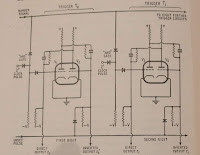The bistable flip-flop 60 years on
 | |
| flip-flop from 'Electronic Computers' | - T.E. Ivall |
The flip-flop lies at the heart of digital electronics.The thing that makes digital computers so powerful is memory. Memory can store the data that programs work on, and it can also store the the programs themselves. Early computers used a variety of techniques for storage but almost all of them used flip-flops to some extent.
The bistable flip-flop is a very simple circuit. It can store a single binary digit (bit) of information. The flip-flop was not new in 1960. The original patent was granted to the inventors (Eccles and Jordan) in 1918. That was long before the transistor was invented: the first flop-flops used valves (US: vacuum tubes).
Valves were still used in computers in 1960, but transistors were beginning to replace them. Transistors were expensive but I managed to buy a few from Proops*, a famous electronic components store in Tottenham Court Road, and I soldered two transistors together with a few other components to make a flip-flop.
* Proops still exists, albeit in a rather different format. They now support hobbyists, jewellers, craft makers and modelling enthusiasts, and run a mail order business from rural Leicestershire.
 A bistable flip-flop is a symmetrical circuit. At any given time one of the transistors is 'on' and the other 'off'. In an S-R flip-flop (the one I made back in 1960) a pair of buttons allowed you to put the flip-flop into either of its stable states.
A bistable flip-flop is a symmetrical circuit. At any given time one of the transistors is 'on' and the other 'off'. In an S-R flip-flop (the one I made back in 1960) a pair of buttons allowed you to put the flip-flop into either of its stable states.I had to check the output using a multimeter; the transistors I used couldn't drive a light bulb, and LEDs were not yet invented.
A few days ago I decided to recreate the circuit using modern components. I started with a breadboarded version but since then I've built a more permanent flip-flop using stripboard. The layout reflects the symmetry of the circuit.
The physical version is reassuringly similar to the fritzing design.
Modern memory is based on a more complex version of the circuit, and modern computers contain a lot. You'd need 8 billion flip-flops to store a Gigabyte of data!
In last Wednesday's #MakersHour session on twitter, someone suggested that we should be capturing knowledge of original computer technology while olders like me are still around to recall it. Tweet to me (@rareblog) if you'd like to see more about early computer technology!





Comments
Post a Comment